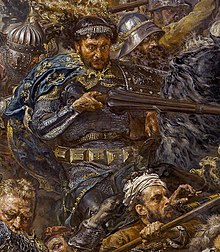Zawisza Czarny
| Zawisza Czarny | |
|---|---|

Zawisza Czarny in a detail of Jan Matejko's Battle of Grunwald
|
|
| Born |
c. 1379 Stary Garbów, Kingdom of Poland |
| Died | 12 June 1428 Golubac, Serbian Despotate |
| Service/branch | Cavalry |
| Rank | knight |
| Memorials | Golubac fortress |
| Relations | Sulima coat of arms |
Zawisza Czarny ([zaˈvʲiʂa ˈt͡ʂarn̪ɨ] or Zawisza the Black; c. 1379 – 12 June 1428), Sulima coat of arms, was a Polish knight and nobleman who served as a commander and diplomat under Polish king Władysław II Jagiełło and Hungarian-Bohemian king Sigismund of Luxembourg. During his life, he was regarded as a model of knightly virtues and was renowned for winning multiple tournaments. His nickname is due to his black hair and his custom-made, black armor, which is kept at the Jasna Góra Monastery.
Zawisza was born in Stary Garbów, Kingdom of Poland (in modern south-eastern Poland), into a local noble family (of the Sulima), his father Mikołaj being the castellan of Konary-Sieradz (konarsko-sieradzki), while his mother was named Dorota. He had two younger brothers: Jan called "Farurej", the starost of Spisz; and Piotr called "Kruczek". In 1397, Zawisza married Barbara of the Piława clan, the niece of Bishop of Kraków Piotr Wysz, and they had four sons.
In 1410 he took part in the Battle of Grunwald against the Teutonic Order. After the battle he and his close friend Stibor of Stiboricz proposed a peace treaty between the King Jagiełło of Poland and Sigismund of Luxembourg, then King of Hungary, which came to be known as the Treaty of Lubowla. In 1412 he participated in the conference between Sigismund, Wladyslaw II and Tvrtko II of Bosnia at Buda, where he won the tournament held there, with 1,500 knights present.
...
Wikipedia
